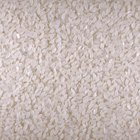
One of the crucial skills every cook acquires over time is the ability to substitute ingredients on the fly, when it's necessary. For example, if you normally thicken a sauce with all-purpose flour and find you've run out, you can use bread flour instead. All wheat flours are similar enough to use for thickening purposes.
How Flour Thickens
Most of your flour consists of tiny granules of starches, bound together into tightly packed balls. When you moisten and heat those starches, they absorb water and begin to swell. This is exactly what you see when pasta expands during cooking. When the heat of your liquid rises above 126 degrees Fahrenheit, the starch molecules begin to "gelate." That means their tight granules begin to burst open, freeing the chains of starches. As the temperature continues to rise, those freed starches reconnect into a fine mesh, like a sponge, and bind the liquids into a gel. Depending how much flour you've used, the end result might be a thick pudding or a smooth sauce.
Wheat to Flour
All flour types owe most of their character to the anatomy of wheat kernels, or "wheat berries," as they're often called. Each kernel of wheat is a seed that's intended to grow a new wheat plant. Wheat germ is the portion of the kernel that produces the new plant, and wheat bran provides the protective coat that encloses the seed. The remaining starchy portion, called the endosperm, is the food supply for the new plant. The germ and bran are removed to make white flour and added back in after milling to produce whole wheat flour.
Starch in Flour
Although the endosperm is primarily made up of carbohydrates, or starches, it isn't a pure starch. Like potatoes, different kinds of wheat vary in the amount and type of starch they contain. The endosperm also contains proteins and small amounts of fiber and other substances. On average, according to food science writer Harold McGee, flour in the United States averages 75 percent starch. This means most are equally effective as thickeners.
Bread vs. All-Purpose Flour
In the case of bread flour and all-purpose flour, the primary difference is their levels of protein. The all-purpose flour sold in most parts of the country is 10 to 12 percent protein, though regional brands can be lower. Bread flour averages 12 to 14 percent gluten-forming proteins, making breads that rise lighter and have better crust. When you use either flour for thickening a sauce, the proteins cook out and form the familiar froth you skim from the top of your gravy. Bread flour might throw off slightly more foam, but your sauces will thicken the same way they would with all-purpose flour.
Related Articles

Can You Use Bread Flour Instead of ...

What Additives Are in Flour?

Why Does Milk Curdle When Baking a ...
Is Unbleached Flour the Same as ...

What Kind of Oil Do You Use in Brownie ...

Differences Between Tapioca Starch and ...
What Is the Difference Between Cake ...

How to Replace Wheat

Does a Rice Flour Thickening Agent Have ...

How Many Calories in Gluten-Free Bread?

How to Add Gluten to All-Purpose Flour

What Is the Nutritional Value of Wheat?

Butter to Flour Ratio for Croissants

Bread Flour vs. Cake Flour in Sponge ...

Can I Substitute Bleached for ...

Is Teff Flour Gluten-Free?

How Much Flour to Thicken a Sauce?

Psyllium Husk & Gluten

Calories in Gluten Free Pasta

How to Bake With Rice & Potato Flours
References
- On Food and Cooking: The Science and Lore of the Kitchen; Harold McGee
Writer Bio
Fred Decker is a trained chef and prolific freelance writer. In previous careers, he sold insurance and mutual funds, and was a longtime retailer. He was educated at Memorial University of Newfoundland and the Northern Alberta Institute of Technology. His articles have appeared on numerous home and garden sites including GoneOutdoors, TheNest and eHow.
Photo Credits
Ryan McVay/Photodisc/Getty Images